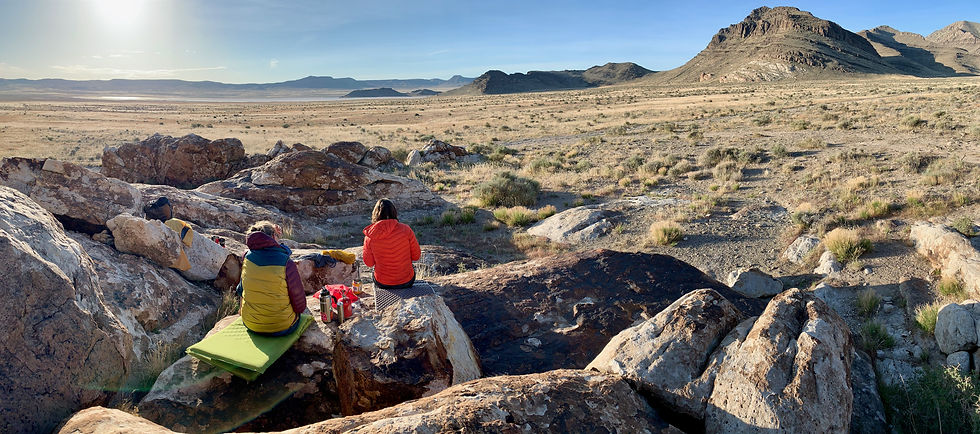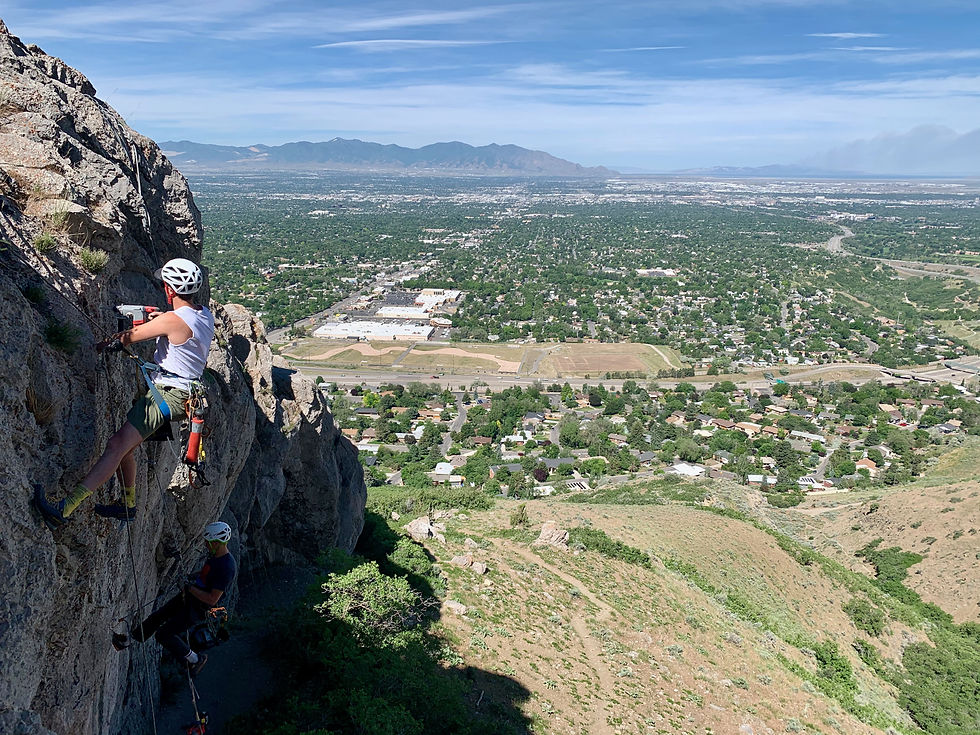#CoronaLyfe: Livin' the Vida Local
- Jesse
- Jul 13, 2020
- 7 min read
Well...
Emilie's private Ortler Alps Ski Tour and my Wasatch Chalet Ski Camp were both cancelled back in March/April...and then.....
As we muddle on into mid-summer, and old friends and partners have reached out to say hello, it's time for an update.
The Certified Guides Cooperative has recently reactivated operations, including our commercial permit as members on the Wasatch National Forest. There are additional policies & procedures in place- like local trips, separating camp and food prep, pre-screening, and wearing masks when unavoidably close- like at belays. So guiding is available for those client partners that are interested, willing and healthy. As always, the inherent climbing risks are managed as best as possible, and now the same goes for this coronavirus, for everyone involved.
In addition to our availability in the Wasatch, Emilie will be guiding and has some availability with Exum Mountain Guides up in the Tetons. Due to necessary distancing, operations are limited, especially to climb the Grand Teton via the Lower Saddle camp. For those interested and able though, the alpine climbing on other peaks in the Park - like the Middle Teton, Teewinot, Nez Perce and Mt. Moran- are enjoyable and less busy options.
CLIMBING ANCHORS
This picture occasionally pops up in my social media feeds. I'm not sure who or where he is. My guess is it's somewhere in eastern Europe and the dude is gettin' it done old-school style, supported only by a girth-hitched spike, an iron fist, a hip belt, suspenders, and big balls.

Hardman. Noun. (plural hardmen) (slang) A man who is particularly tough or muscular.
Used to refer to a mentally and physically tough climber. - Urban Dictionary
I've never climbed in eastern Europe, but I understand that protection in the softer rock types is limited by local ethics and management, to big runouts between huge steel ring anchors.
I am plenty familiar with, but don't particularly go looking for big runouts. However, I do like the idea that whatever anchors are installed, they are absolutely bombproof. You could still take a huge whipper and get banged up, but the anchor won't fail. No wonder that guy's balls are big!
#QUARANTEAM GOALS
One of the noticeable effects of #CoronaLyfe in the Wasatch has been an increase in dispersed recreation. For a city, it is relatively easy to get outside in Salt Lake, and also to keep some distance while skiing, climbing, biking, hiking and trail running. Access to outdoor recreation has been an important part of 'self-care' for a lot of people. Turns out that to get through this pandemic- in addition to access to reliable health care for all of those affected by it- people also need access to reliable and responsible recreation to stay healthy. A skilled and capable #quaranteam to play with always helps.

Three IFMGA guides on our #quaranteam this April day on the Pfeifferhorn's North Ridge. We've got all of the PPE to manage the climbing hazards, and the skills and resources to self-rescue.

#Quaranteam climbing and camping a week later in Utah's West Desert.
CLIMBING ANCHORS as RECREATION INFRASTRUCTURE
Not surprisingly, a recent Salt Lake Climbers Alliance community survey identified what the thousands of local climbers want most in terms of community support and resources- is reliable climbing anchors.
The Wasatch has a rich legacy of climbing and new route development, from a major scene for sport climbing on steep limestone in American Fork Canyon, to the old-school crack and slab routes in Little Cottonwood Canyon, and a real mix of everything on Big Cottonwood's featured quartzite. Local climbers move freely between outdoor crags and several of the country's best climbing gyms.
Unfortunately though, many of the bolts placed on first ascents and earlier generation climbs - all of which see ever increasing amounts of recreational use from over ten thousand (self-identified) local climbers- are approaching or are past their reliable service life.

WARI Volunteers Jimmy and Tim replacing all of the anchors at The Reef- a neighborhood limestone sport climbing crag just above the Salt Lake Valley.
The SLCA's Wasatch Anchor Replacement Initiative- a volunteer group composed of OG Wasatch First Ascensionists and some very talented Young Guns- started organizing and addressing the issue in 2014. They run volunteer committee events and collective efforts to replace unreliable anchors- all of which are helpfully reported here. Their cumulative efforts are a huge gift to the local climbing community.
But there are thousands and thousands of anchors across multiple venues in the Wasatch (not to mention the neighboring Uintas), and ever-increasing use with a strong assumption of anchor reliability born from sport and gym climbing. Routes that were established as an epic battle of survival and adventure drilling on lead- making a 1/4" pounded rivet (or stacked washers and chain links) seem relatively 'good enough' - may not be the best solution for long-term enjoyment of the route. To be clear though- the SLCA operates from a fundamental premise of 'hole-for-hole' replacement whenever practicable- this is primarily maintenance, not re-routing.
Once those routes become shared and documented community resources, it's time to start accounting for these. In a perfect world- old anchors would continue to get maintained and replaced as needed, and any new routes going in would be informed by the same standards and 'best practices': all stainless steel hardware, the appropriate type of anchor for the rock and terrain (i.e. expansion sleeve or 'glue-in' bolts), installed on a known date, according to manufacturer's specifications, and good to go for the next 25-50 years.
PROFESSIONAL ANCHOR REPLACEMENT
The SLCA represents one of the largest and most active urban climbing communities in the country. One of the organization's evolutions has been the move to hiring skilled professional trail building crews for long-term access trails, coordinated with the land owners and property managers. The trail work that has been done is truly craftsman quality, and will become sustainable infrastructure for decades of use, and generations of climbers.
Anchor replacement is not recreational climbing, it's real work, and 'at-height' - with all of the hazards of cutting and grinding on a rope. It shouldn't be as risky as climbing- we do not want our community friends and partners getting hurt doing it. And if we're taking the time to do it, it should also be done correctly, and result in an anchor that is as reliable and durable for as long as possible. All climbing will still- no matter what or where- require a fundamental and primary assumption of risk. There are no guarantees in a non-engineered environment.

Adhesive 'glue-in' anchors can be one long-term solution, but require good storage & handling of the epoxy, and present limited options for later replacement.
What about land management concerns? The Forest Service does not have a consolidated nationwide policy on managing climbing anchors. But neglecting their existence- and the climbers using them every day- won't make the issue go away, or improve the status quo. What can climbing organizations do to present a legitimate solution to the Forest Service?
Carpentry and construction has been a handy 'side gig' all of my life, and a good complement to a mountain guiding career. During my time managing Petzl America's Technical Institute, I had the opportunity to expand beyond climbing and sport, and to train and work a little with experts in industrial rope access, tower climbing, technical rescue, arborism, general fall protection and navigating the respective industrial safety standards. I really enjoy the overlap between all of these worlds- or what the Petzl family would simply call 'Verticality.'
When the Climbing Wall Association stepped up to address industry wide 'Work At Height' standards in climbing gyms for routesetting and maintenance, we worked to develop an industry specific program that includes an appropriate mix of both climbing and rope access techniques and systems. Continuous improvement of that program will be an ongoing aspect of professionalization in that industry, and support the workers that commit to it.
This spring, the SLCA approached me about a somewhat similar project- but in the context of professional anchor replacement work. As with the trail crews- what would a paid anchor replacement crew look like? What would an OSHA compliant Managed Fall Protection Program for this kind of work- with a mix of climbing instructor/guide and rope access technician skills- look like? How do you qualify that to underwriters, land managers and potential sponsors? What would program management, job hazard analysis, worker training & assessment, and a plan for worker rescue look like? (Google 'angle grinder injuries' if you think nothing could happen.)
Can we define, hire and train a small team of 'Competent Workers' (a work safety term)? Can we field-test it and refine it in the Wasatch- where the Gate Buttress property in Little Cottonwood Canyon provides a perfect test-lab, to improve our methods and get accurate estimates on labor, materials and timing? If it works, is this a model template that we can share with the Access Fund, and other Local Climbing Organizations?
We're working on the final drafts of program development now- with tentative plans to train an eligible pool of workers in August, drawn from the already very skilled and experienced WARI Volunteer Committee, and do the field work in September.
Not surprisingly these days, funding for the field portion is still unconfirmed. If you support the professionalization of anchor replacement and would like to see a program that can be shared for all climbers' benefit- consider donating to the Salt Lake Climbers Alliance.
I'll continue to guide privately and part-time in addition to this work. It's important for me to exercise these technical skill sets and maintain long-term parter relationships- as much as we can these days. But after twenty-five years of mountain guiding and instruction all over the country as my primary work, and a fiftieth birthday on the not-too distant horizon, this is a welcome progression. Supporting community resources is a high priority these days, and I'm pleased to be the Anchor Replacement Coordinator for the Salt Lake Climbers Alliance.

















Comments